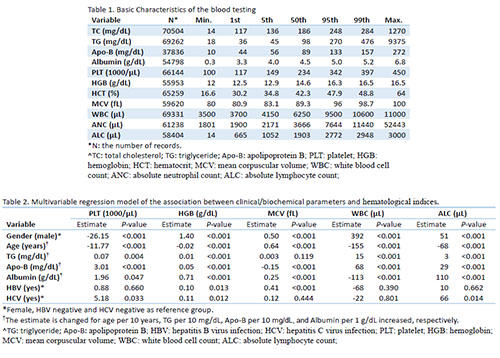
Contributions
Abstract: PB2093
Type: Publication Only
Background
Studies in Caucasians have shown that values of hematological parameters could be affected by a wide variety of factors, most notably age and gender. However, parallel work in different ethnical populations, especially from Asia-Pacific region, is lacking. Importantly, it remains largely unknown whether some fundamental variables such as nutritional status, lipid profile, and hepatitis infection (either HBV or HCV) also affect the variation of values in hemogram.
Aims
Therefore, we conceptualize this study to explore through several key parameters regarding their potential impacts on the changes of hemogram.
Methods
Adult individuals aged 18 or older from several adjacent villages in Yun-Lin County, located in the central part of western Taiwan, who came to our hospital for annual health exams were screened for the current study. The work, retrospective in nature, was approved by institutional IRB. Information on age, gender, hemogram, levels of total cholesterol (TC), triglyceride (TG), apolipoprotein B (Apo B) as well as albumin, and results of serological testing for hepatitis B and C infection, was obtained from a centralized digital data base. All the clinical data, after given a coding number for each case, were encrypted and provided to the investigators without identifiable personal information. We analyzed the impacts of various parameters on several key hematological indices.
Results
Overall, 26,497 individuals were included in the current analysis after excluding those with hemogram data fell outside of normal range. Carriers of either hepatitis B (HBV) or C (HCV) who had abnormal liver function (defined by elevated levels of aspartate transaminase or alanine transaminase) were excluded as well. Age, gender, and serum levels of TC, Apo B, and albumin all significantly impacted most key hematological profiles. As the levels of TC and Apo B correlated well with each other (correlation coefficient r = 0.82211, p < 0.0001, Pearson’s correlation), we did not incorporate TC in our multi-variate analysis. Several key variables were found to influence some hematological indices in the multi-variable regression model. Increasing age and male gender negatively affected the platelet count, whereas higher Apo B level was associated with elevated platelet count. Surprisingly, hepatitis C carriers with normal hepatic function had slightly higher platelet number than non-HCV carriers. Gender and serum albumin level were the major determinants of variation in hemoglobin level. Total white cell count increased with male gender and elevating Apo B level but was inversely correlated with change in age and serum albumin level.

Conclusion
The hematological indices are influenced by a wide variety of factors, especially age, gender, and serum level of Apo B. As age, Apo B, white cell count, and platelet count all impose risk of thromboembolism, further work exploring the interactions and impacts of these parameters on the development of cardiovascular diseases should be mandatory.
Session topic: 31. Other Non-malignant hematopoietic disorders
Keyword(s): Cholesterol, Age, Platelet count, Gender
Abstract: PB2093
Type: Publication Only
Background
Studies in Caucasians have shown that values of hematological parameters could be affected by a wide variety of factors, most notably age and gender. However, parallel work in different ethnical populations, especially from Asia-Pacific region, is lacking. Importantly, it remains largely unknown whether some fundamental variables such as nutritional status, lipid profile, and hepatitis infection (either HBV or HCV) also affect the variation of values in hemogram.
Aims
Therefore, we conceptualize this study to explore through several key parameters regarding their potential impacts on the changes of hemogram.
Methods
Adult individuals aged 18 or older from several adjacent villages in Yun-Lin County, located in the central part of western Taiwan, who came to our hospital for annual health exams were screened for the current study. The work, retrospective in nature, was approved by institutional IRB. Information on age, gender, hemogram, levels of total cholesterol (TC), triglyceride (TG), apolipoprotein B (Apo B) as well as albumin, and results of serological testing for hepatitis B and C infection, was obtained from a centralized digital data base. All the clinical data, after given a coding number for each case, were encrypted and provided to the investigators without identifiable personal information. We analyzed the impacts of various parameters on several key hematological indices.
Results
Overall, 26,497 individuals were included in the current analysis after excluding those with hemogram data fell outside of normal range. Carriers of either hepatitis B (HBV) or C (HCV) who had abnormal liver function (defined by elevated levels of aspartate transaminase or alanine transaminase) were excluded as well. Age, gender, and serum levels of TC, Apo B, and albumin all significantly impacted most key hematological profiles. As the levels of TC and Apo B correlated well with each other (correlation coefficient r = 0.82211, p < 0.0001, Pearson’s correlation), we did not incorporate TC in our multi-variate analysis. Several key variables were found to influence some hematological indices in the multi-variable regression model. Increasing age and male gender negatively affected the platelet count, whereas higher Apo B level was associated with elevated platelet count. Surprisingly, hepatitis C carriers with normal hepatic function had slightly higher platelet number than non-HCV carriers. Gender and serum albumin level were the major determinants of variation in hemoglobin level. Total white cell count increased with male gender and elevating Apo B level but was inversely correlated with change in age and serum albumin level.

Conclusion
The hematological indices are influenced by a wide variety of factors, especially age, gender, and serum level of Apo B. As age, Apo B, white cell count, and platelet count all impose risk of thromboembolism, further work exploring the interactions and impacts of these parameters on the development of cardiovascular diseases should be mandatory.
Session topic: 31. Other Non-malignant hematopoietic disorders
Keyword(s): Cholesterol, Age, Platelet count, Gender


